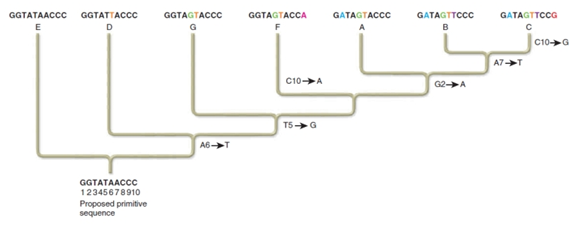If a cell is permeable to a solute, that solute will diffuse either into or out of the cell depending on the direction of its concentration gradient
a. True
b. False
a
You might also like to view...
What nucleotide change is a shared derived character for species A, B, and C, but not for species G?

A,T,G, and C refer to nucleotide bases, and the numbers refer to the position of the base in the nucleotide sequences.
For example, A6 refers to an adenine at the sixth position.
A. Changing the second G to an A is common to species A, B, and C, but not to species G.
B. Changing the fifth T to a G is common to species A, B, and C, but not to species G.
C. Changing the second G to a T is common to species A, B, and C, but not to species G.
D. Changing the second G to an A and the fifth T to a G is common to species A, B, and C, but not to species G.
E. None of these show a change in derived characteristics for A, B, and C that are not found in G.
Which of the following are the best examples of homologous structure?
a. The finger bones found in humans, bats, and whales b. Wings in both birds, bats, and bees c. Beaks of birds and squid d. The streamlined, hydrodynamic bodies of both dolphins and sharks
Which system involves plasma proteins
activated when an organism's pattern receptors become bound to anything? a. cytokine b. complement c. suppressor d. enhancer e. coagulation
Which statement is true concerning human genetic
disorders? a. There are more than 15,000 of them. b. Many are rare. c. They contribute to many age-related disorders. d. They cause 20 to 30 percent of all infant deaths per year. e. All of these are true.